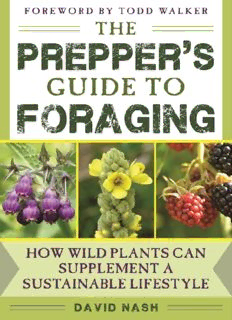
The Prepper's Guide to Foraging : How Wild Plants Can Supplement a Sustainable Lifestyle PDF
Preview The Prepper's Guide to Foraging : How Wild Plants Can Supplement a Sustainable Lifestyle
Copyright © 2016 by David Nash All rights reserved. No part of this book may be reproduced in any manner without the express written consent of the publisher, except in the case of brief excerpts in critical reviews or articles. All inquiries should be addressed to Skyhorse Publishing, 307 West 36th Street, 11th Floor, New York, NY 10018. Skyhorse Publishing books may be purchased in bulk at special discounts for sales promotion, corporate gifts, fund-raising, or educational purposes. Special editions can also be created to specifications. For details, contact the Special Sales Department, Skyhorse Publishing, 307 West 36th Street, 11th Floor, New York, NY 10018 or [email protected]. Skyhorse® and Skyhorse Publishing® are registered trademarks of Skyhorse Publishing, Inc.®, a Delaware corporation. Visit our website at www.skyhorsepublishing.com. 10 9 8 7 6 5 4 3 2 1 Library of Congress Cataloging-in-Publication Data is available on file. Cover design by Tom Lau Cover images courtesy of iStock.com All photos in insert courtesy of iStock.com Illustrations by Sarah E. Cole Print ISBN: 978-1-63450-493-5 Ebook ISBN: 978-1-63450842-1 Printed in the United States of America Table of Contents Dedication Foreword by Todd Walker Introduction Photo Insert Part I How to Learn About Wild Edible and Medicinal Plants Universal Edibility Test Is Foraging an Appropriate Prepper Plan? Medicinal Uses of Plants Commonly Used Plant Parts Basic Types of Herbal Treatments Botanical Description Definitions Part II American Basswood Birch Blackberries Cattails Comfrey Common Yarrow Dandelion Eastern Red Cedar (Juniper) Kudzu Lamb’s Quarters May Apple Milk Thistle Milkweed Mullein Oak Broadleaf Plantain Purslane Sassafras Shepherd’s Purse Staghorn Sumac Stinging Nettle Sycamore Walnut White Pine Willow Suggested Reading About the Author About the Illustrator To my friend W. Smith, Thanks for all the help and support, but mostly all of the well deserved, “That’s a stupid idea, Dave”—because you still helped anyway. Foreword When David Nash asked me to write a foreword to his book, I was extremely honored and excited. I’m a student who enjoys doing common-sense stuff to become more self-reliant. I like the fact that he’s actually doing the stuff in his books, as well as the no- nonsense style of his writing based in humility. His attitude is always that of a student, whether teaching about guns or plants. Knowledge is not enough to get you and your family through hard times when fragile systems fail. As much as we’d all like to think that food trucks will always deliver, a small glitch (or a dusting of snow in Georgia) is all it takes for the industrial food machine to grind to a halt. Not a problem. You’ve got food put aside for such occasions … if the trucks start rolling again soon. What if they don’t? I’ve read many misguided people who plan to “live off the land” in the backwoods. That’s not what this book is about. David puts that myth to rest right up front. Foraging from the landscape is a skill meant to supplement your overall food independence plan. But what many foraging books don’t give you is alternative uses for wild plants … and trees are rarely mentioned. Trees, my friend, are a four-season meal plan! The more I learn about the natural world, the more I realize just how little I know. There are hundreds of thousands of plant species in nature. In my pursuit of outdoor self-reliance skills, knowledge of the plant world is the foundation of becoming less dependent on others. I’m not a botanist, but I do study plants and trees for their use as food and medicine. However, one of the best value-added aspects of this book has to be the alternative uses of each of the twenty-five plants listed. That alone is worth the price. David also provides some excellent resources to further your journey in wildcrafting. The common sense advice to seek out a reputable plant forager is wise. Even then, you’ll need to spend time in the woods or backyard practicing. I would recommend locating and properly identifying two of the plants/trees each month. In one year’s time, you’ll have learned twenty-five plants and their uses. That would be a huge leap in your journey to self-reliance! Todd Walker Todd Walker, aka The Survival Sherpa, is an experienced survivalist who runs several websites and Facebook groups dedicated to wilderness survival and bushcraft.
Description: